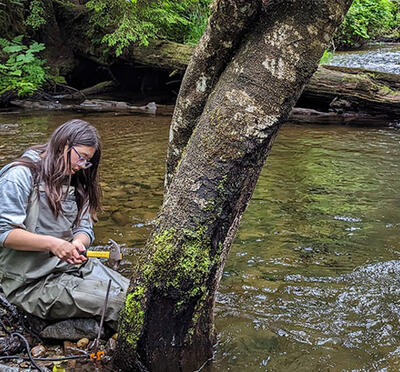When asked why she has focused her career on water, Meghna Babbar-Sebens has a simple answer: “Water is life.”
Clean water is precious in India, where she grew up. According to a recent report by the World Bank, India contains 18% of the world’s population, but just 4% of the world’s water resources.
“Water scarcity was in my face every day,” said Babbar-Sebens, associate professor of water resources engineering. “It’s really important to find better ways of managing water, because what we were doing in the past is not working for our current needs.”
She points out the Colorado River Basin as an example where previous efforts to allocate and manage water are unable to narrow the widening gap between demand and supply, as populations increase and megadroughts chronically restrict supplies.
Too little water is not the only problem. Severe weather events in the past year have caused flooding in places like Iran, Florida, Texas, Pakistan, and Puerto Rico.

Justine Obiazi discuss their “interactive optimization”
platform for soliciting stakeholder input about
computer-generated solutions for re-naturalizing
degraded watersheds.
Babbar-Sebens’s approach is to look to nature for solutions by re-naturalizing degraded watersheds, including restoration of natural areas like wetlands. At the OSU Benton County Green Stormwater Infrastructure Research Facility, her collaborative research group tests green infrastructure options such as raingardens and bioswales — shallow, vegetated Channels — for removing water contaminants. But, as a systems engineer, she looks beyond specific techniques.
“To implement a re-naturalizing approach, you have to look at the entire watershed as a system,” she said. “We ask: ‘Where can we implement these practices across the landscape in a way that is distributed and networked?’”
In developing solutions, she says, it’s critical to include the perspectives of many stakeholders such as landowners, planners, water managers, tribes, and state and federal agencies. A solution is only viable if it is acceptable to all decision-makers.
To include stakeholder input in the evaluation of water management options, Babbar-Sebens has collaborated with computer scientists and social scientists to create a system that integrates the power of computing with human evaluation.
Through a process called interactive optimization, computers perform the numerical evaluation (costs and benefits) of thousands of different design options, and people rate the best designs selected by the algorithm. Babbar-Sebens and her collaborators developed web-based tools that help stakeholders visualize possible solutions with maps and graphs. The interface collects responses to simple questions like, “Is this plan acceptable to you?” or “How does plan A compare to plan B?” Machine learning can then identify features of the plans that are more acceptable to people, and narrow down thousands of options to a select few that the community agrees on.
Babbar-Sebens has tested her method in places like the Eagle Creek watershed in Indiana and with rural communities in India. The data she has collected is helping her to refine the system. She says that tackling complicated problems like water management requires connections with community, collaborations across disciplines, and courage.
“When you think about adapting to climate change, it’s going to require courage from all of us to think differently,” she said. “Not just courage from engineering disciplines, but courage from communities to invest in ways to solve these problems.”
The research was supported by the National Science Foundation, the National Institute of Food and Agriculture, and the National Oceanic and Atmospheric Administration.



